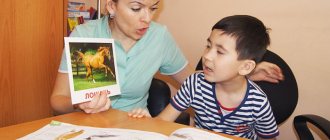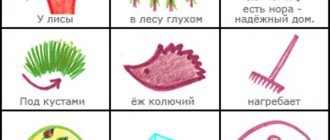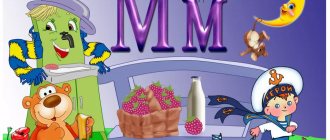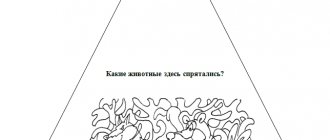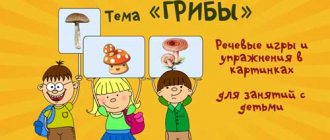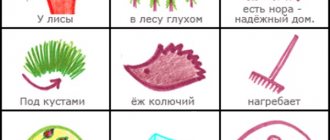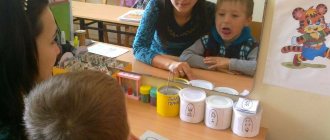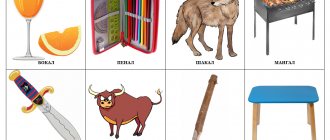What is mnemonics
Mnemonics are aimed at developing and improving memorization skills. The system of methods and exercises used in it allows a person not only to memorize the necessary material faster and more efficiently, but also to reproduce it. Mnemonics are becoming increasingly popular and are used when working with people of different ages.
It affects not only memory, but also the development of coherent speech. It is based on visual perception of the material and its further reproduction using pictures. The essence of working with a mnemonic table is simple: the child forms an associative connection between a certain word/phrase and an image. Then the word is depicted schematically.
The student carefully studies the images shown, which further facilitates rapid memorization and reproduction of text information. And this has a beneficial effect on his speech development.
Advantages of mnemonic tables
The use of this table greatly simplifies the learning process, which is why it is very popular among teachers, including speech therapists. Mnemonics significantly accelerates the development of coherent speech in preschoolers. It contains bright pictures that simplify the learning process for a preschooler.
Bright, clear diagrams help master the skill of composing sentences and logical chains. In the future, it will be easier to compose texts with detailed descriptions and clarifying details. What are the main advantages of using mnemonic tables in the classroom?
- Development of visual and auditory memory.
- It is easier for a child to learn poems, retell given texts (especially fiction), and solve logical problems.
- Development of coherent speech, which also affects communication skills.
- Development of associative thinking.
The listed advantages make mnemonics increasingly in demand. Mnemonic tables are one of the main techniques in working with preschool children.
How to teach children to compose texts using a mnemonic table
You should start with the simplest tables, consisting of 4 (2x2) cells, gradually complicating the task and increasing the number of rows. Based on such visualization, children themselves will be able to compose a descriptive story. The training consists of several stages:
- First, we consider and discuss each picture in detail. We ask children leading questions that focus on details: shape, size, color and other characteristics.
- We “recode” the information encrypted in conventional symbols. All children should understand what is being said.
- We propose to compose phrases for each mnemonic square.
- We combine them into a story and say it out loud.
- We remove the table and invite the children to reproduce it graphically from memory.
- Now it’s the kids’ turn to present their version of the story.
For example, you can teach children to describe their favorite time of year using a table like this:
- A good place to start is by taking a closer look at all the images used: “What do you see in the pictures?”
- The second step is decoding the information hidden in the symbols: “What time of year are we talking about? Right. So what could the letter “B” in the first square mean? And what kind of strange people are depicted at the end of the table? Yes, these are girls in blue dresses and boys in orange trousers.”
- Then, together with the children, we make up phrases for each picture: “Spring has come. The snow melted and green grass appeared. Snowdrops bloomed. The birds have arrived. Young leaves bloomed on the trees. Girls and boys are glad to see the warm sun.” The adult says the full version of the story out loud, linking each sentence to a picture.
- We remove the table and invite the children to reconstruct it from memory.
- The next step is test stories, first based on visual aids, and then without it, from memory.
So gradually the tables become larger and the texts more complex. But no matter what topic you touch on, the algorithm for teaching how to write stories will remain the same.
When to use mnemonic tables
This didactic material is most often used when working with children with learning difficulties. It is especially effective in classes with those who have speech problems. Mnemonic tables should definitely be used if:
- children's speech consists of simple sentences and phrases;
- it is difficult for a child to form logical chains;
- vocabulary lags behind the norm;
- difficulty formulating questions and answers;
- diction is broken.
Mnemonics allows you to eliminate these difficulties. At the same time, the child will be interested in the lesson, because he sees bright pictures.
Common speech problems in preschool children
In most cases, girls and boys of preschool age should already be able to fully operate with synonyms and a variety of images, describe all current events, using vivid, but at the same time grammatically correct word forms. But, unfortunately, not all preschoolers can boast of such skills. Most children face various speech problems:
- Inability to compose long, complex sentences - the child’s speech consists exclusively of simple, laconic sentences.
- The child cannot independently formulate a logically correct and complete sentence.
- Systematic use of non-literary vocabulary.
- Minimal, poor vocabulary that does not correspond to the child’s age category.
- A preschooler cannot independently formulate questions and answer questions posed.
- Poor level of diction.
- A preschooler cannot draw correct logical conclusions and statements.
To correct such speech defects, mnemonics are often used, which have become widespread among many specialists.
Manufacturing technology
You can purchase ready-made teaching material. But mnemonic tables are easy to make yourself. In classes, ready-made options developed by V.K. Vorobyova or T.A. Tkachenko are most often used.
These mnemonic tables are taken as a basis and modified depending on the individual characteristics of the child.
You need to choose a word or phrase and an image that represents it. For children of primary and secondary preschool age, it is best to choose bright images - this will make it easier for the kids to remember the necessary material.
Then, when children learn the word and remember the picture, it can be replaced with a graphic symbol. For example, a squirrel - on a brown circle. With the help of such mnemonic tables, short fairy tales are retold: they can use both images and combine them with graphic symbols, or use graphic symbols entirely.
Such model schemes are used to study the characteristics of an object. Therefore, the main topics of classes using the didactic manual are the study of color, shape, size, texture of an object. The teacher can also ask the children what parts a particular object consists of, where it is used, what can be done with it and what cannot be done. Before asking questions, the child, together with an adult, carefully studies the mnemonic table.
Features of using mnemonic tables
Despite the effectiveness of this manual, it must be used correctly in order to develop all the necessary skills in children. A special feature of mnemonic techniques is the visualization of text information. The teacher acts according to a certain scheme so that the use of this technique is effective:
- An adult shows a group of children cards with bright images that will represent certain words/phrases.
- Next comes the study of mnemonic tracks. Mnemonic tracks are a series of images (usually up to 4). With their help, the child can make up a short story.
- The most difficult stage is the use of mnemonic tables to form coherent speech.
The specialist uses the following techniques in his work:
- cards with pictures of actions - help to master verbal vocabulary;
- mnemonic tracks, consisting of several pictures, from which the child can compose a fairy tale or story;
- quick and easy memorization of poems.
When the number of pictures-symbols is sufficient, you can offer a task to “decipher” graphic letters. If the lesson is in a group, children can decipher it at speed. Another task for working with a group is to see who can remember the most words. The competitive element makes the lesson more interesting, and children have an incentive to practice more diligently.
Another interesting task is to compose a funny story from words and pictures. But you need to connect words sequentially, without skipping. In this way, children develop the ability to form logical chains. It is also useful to include tasks to train not only memory, but also attentiveness (“What has changed in the picture”, “Find the differences”, “Abstract artist” and others).
You need to select lexical topics in accordance with the level of the child’s vocabulary and his age. Then the use of modular schemes will be useful for speech development.
“Mnemonics as a current technology in implementing the tasks of educational areas in preschool educational institutions
Municipal preschool educational institution
d.s. Kalininskoe village
Marksovsky district, Saratov region
Master Class
“Mnemonics as a current technology in implementing the tasks of educational areas in preschool educational institutions”
Prepared and conducted by the teacher:
Yakovleva N.V.
1.Purpose of the master class:
Familiarization of teachers with the educational technology of mnemonics, which ensures effective memorization.
2
Educational technology mnemonics is a system of methods and techniques that ensure effective memorization, preservation and reproduction of information, as well as the development of speech, memory and thinking of preschoolers. Mnemonics for preschoolers helps simplify the memorization process,
This technology is used to implement tasks in all educational areas .
3
The purpose
of teaching mnemonics:
the development of memory, thinking, imagination, attention, namely all processes associated with the full development of speech.
Tasks of mnemonics :
1.Develop the ability to understand and tell a text using a graphic analogy.
2. To develop in children mental activity, intelligence, observation, the ability to compare, and identify essential features.
3. Develop mental processes in children: thinking, attention, imagination, memory.
4. Contribute to the solution of inventive problems of a fairy-tale, playful, environmental, and ethical nature.
5. Teach children correct sound pronunciation.
6. To cultivate in children the need for verbal communication for better adaptation in modern society.
4
The essence of mnemonics is as follows: for each word or phrase a picture is created, thus the entire text is sketched out schematically. Looking at these drawing diagrams, the child easily reproduces textual information. Schemes serve as a kind of visual plan for creating monologues, help children build: coherence, consistency, lexical and grammatical content of the story.
5
Like any work, mnemonics is built from simple to complex. It is necessary to start working with the simplest mnemonic squares , sequentially move on to mnemonic tracks , and later to mnemonic tables
6
Mnemonic squares
To begin with, children are introduced to mnemonic squares. Mnemonic square
is a graphic or partially graphic image of an object, natural phenomenon, fairy tale character, etc., which denote one word, phrase, its characteristics or a simple sentence.
For children of primary preschool age, color images are best suited, since sensory standards are formed; children retain individual images : a green Christmas tree, a yellow bun, etc. Later, the pictures are replaced by a graphic image : a fox - orange geometric shapes (circle, square)
and etc.
For older children, the diagrams are given in one color. But based on my experience, I noted that older preschoolers are also interested in color images, so in my work I use color pictures along with schematic images.
Elements of support diagrams and symbols are used in all types of classes, in various types of activities, since the child should not have a “habituation”
, that this symbol is applicable only in one area because the symbol is universal.
7
After getting acquainted with the mnemonic square, the lesson becomes more complicated, demonstrating mnemonic tracks - this is already a track of four pictures, from which you can compose a short story in 2-3 sentences. Mnemonic track
– carries a small amount of information, the essence is this: for each word or small phrase an image is invented; thus, the entire text is drawn schematically. Looking at these drawings - diagrams, the child can easily reproduce text information.
8
Mnemonic table
- This is a diagram that contains certain information.
The following are used as substitute symbols: subject pictures, silhouette images, geometric figures. thus, the entire text is sketched schematically. Each cell in this table can correspond to one word or an entire phrase. Initially, the tables are compiled by educators, then the child can be involved in this process, thus, mnemonics will affect not only the development of memory, but also the imagination, visualization of images by the child, what is drawn is better imprinted in memory, because not only the word, but also the image is fixed . In the future, having picked up this kind of “cheat sheet”
, the child will be able to reproduce information more successfully.
The size of mnemonic tables can vary depending on the age of the children and their level of development.
It is recommended to use the following table sizes: • for younger preschoolers - tables for 4 - 9 cells
• for older preschoolers - tables up to 25 cells.
9
There are stages of working with mnemonic diagrams.
Stage 1: Examination of the table and analysis of what is shown on it.
Stage 2: The information is recoded, i.e. transformation from abstract symbols of words into images. or children’s independent search for images symbolizing some quality.
Stage 3: After recoding, a retelling of the fairy tale is carried out, a story on a given topic. or reading a poem based on symbols (images), i.e. the memorization method is being developed.
10
You can start studying mnemonics from a young age, but it is more rational to introduce it into classes from 4-5 years old, when children have accumulated a basic vocabulary.
Mnemonics can be used to implement tasks in all educational areas
During experimental activities,
in visual arts they are used as an example of drawing objects ;
when learning poetry, pure sayings;
when writing stories,
when retelling fiction
Guessing riddles;
when teaching the sequence of processes of washing, washing hands, dressing, and setting the table.
11
Now I invite you to participate in compiling a mnemonic table while learning the poem. Listen to him:
“THE FIR-STREET” by N. Nishchev
In front of us is a Christmas tree: Cones, needles. Balls, lanterns, Bunnies and candles, Stars, people.
12
– In front of you are sheets of paper and pencils. I invite you to draw with me. Let's draw schematically.
- “There is a Christmas tree in front of us.” What can we draw for this line? ( Christmas tree
). Right.
The next line is “Needle cones.” Let's draw... Etc.
– Our poem is “drawn”, the mnemonic table is ready. Now, looking at your mnemonic tables, read the poem without relying on the text.
13
Mnemonic tables can also be used when composing descriptive stories. Looking at the diagram, you can describe anything. Using this diagram as an example, I suggest you play with it. Using this diagram as an example, I invite you to play, you guess any vegetable or fruit and, based on the diagram, tell us about it, and we will try to guess it! Try…..
14
I have prepared the following task for you
Teachers are divided into 2 teams. Each team receives a sheet with a task (see appendix)
- Encrypt proverbs into a mnemonic track
The rest of the teams guess.
Seven times measure cut once
Water does not flow under a lying stone
The apple never falls far from the tree
- Create a mnemonic table for the descriptive story “Winter”
15
Thus , the use of mnemonic methods :
• facilitates memorization and increases memory capacity, develops speech and thinking activity of children; reduces memorization time
• allows the child to systematize his direct experience;
• the child, relying on images , establishes cause-and-effect relationships and draws conclusions; develops basic mental processes
• develops children's creative knowledge
Verification of the implementation of assigned tasks and achievement of goals is carried out using reflection
Reflection Technique “Suitcase, Basket, Meat Grinder”:
Three large sheets are offered, on one of which a huge suitcase is drawn, on the second - a trash can and on the third - a meat grinder. Suitcase - you need to draw or write the most important point that he learned from work (in a group, in a lesson), ready to take with him and use in his activities. A trash can is something that turns out to be unnecessary, useless and can be thrown into the “garbage”. A meat grinder is something that turned out to be interesting, but is not yet ready for use in my work. What still needs to be thought out, refined, “tweaked”. The leaves are written anonymously and, when ready, are glued by the participants themselves.
Rules for using mnemonic tables in the classroom
Before including this technique in your work, you need to take into account that preschool children need to be prepared so that they can perceive it. In the initial stages, you should use simple and understandable images. All pictures should be bright, because children will not be interested in studying with a black and white image; it is more difficult to remember.
There should not be too many pictures in the mnemonic track. If there are too many of them, it will be difficult for children of any age to perceive and remember information. Their maximum number should not exceed 8-9 pieces. Also, their number must correspond to the age of the student. Mnemonic tables should cover all lexical topics in order to expand vocabulary and form coherent speech.
Rules for conducting classes
Supporters of early development argue that it is possible to introduce a child to mnemonics as early as 2-3 years, as soon as he has accumulated some vocabulary. Wherein:
- Classes should not last more than 15 minutes. Even in this short period it is worth including physical education or considering a change in the type of activity. After all, due to age characteristics, preschoolers can work concentratedly for only 8–10 minutes, and then their attention wanders.
- The leading activity for children is play, so the activity should not be turned into a strict academic lesson. The baby will better perceive information if it is presented in the form of an exciting, fun adventure.
- Mnemonics includes a lot of techniques and methods, but due to age-related characteristics of perception, the most accessible for children is croquing - the use of visual aids: diagrams, drawings, sketches, tables or collages.
- Regardless of the child’s age, we begin training with the simplest tasks, gradually complicating them.
- Drawings or diagrams must be large, clear and always in color, otherwise the baby will simply not be interested. Only in the preparatory group can children be offered black and white support diagrams.
- The table should not contain more than 9 squares. It is difficult for a preschooler to remember and reproduce a large amount of information due to fatigue.
- To ensure that all the knowledge settles down in memory and does not get mixed up and turn into “porridge,” do not give your child more than 2 mnemonic tables during one lesson.
- Constantly change the topics of texts - this better develops memory and enriches vocabulary.
Be sure to take into account the child’s desire and mood. Under no circumstances force him to use force. If you feel that your baby is bored, take a short break, and then try again to interest the baby by changing the topic. Hitting, shouting, calling names and humiliating children is strictly prohibited.
The effect of using mnemonics
This technique is highly effective. In most cases, children successfully master mnemonics. With its help, children's horizons significantly expand, which affects their vocabulary. There is not only an increase in it, but also a refinement. Also, preschool children master verbal vocabulary, adjectives, numerals, and adverbs better and faster.
In addition, creative thinking develops. Preschoolers enjoy inventing various stories and fairy tales. Children develop an interest in poems and reading in general. And memorization and retelling cause the most difficulties.
Thanks to mnemonics, children experience comprehensive speech development. Since they have developed coherent speech, their communication skills improve. The child is not afraid of public speaking; it is easier for him to communicate with his peers. The use of mnemonics increases the effectiveness of classes with preschool children, turning the learning process into an exciting game.

